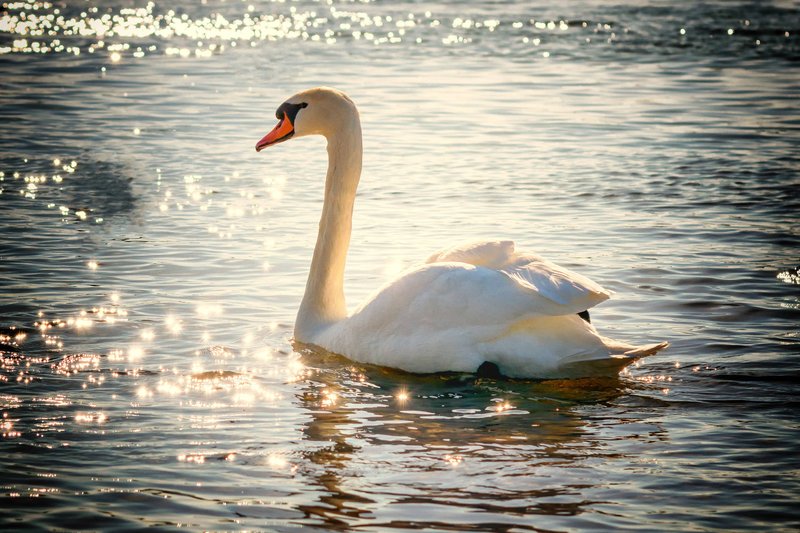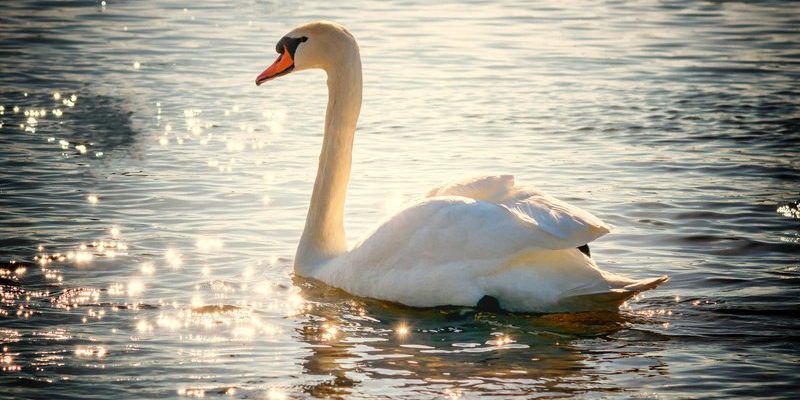
You see, swans are so much more than just pretty faces. They’re strong, social, and interesting birds with a wealth of knowledge tied to their existence. So grab a cup of coffee, and let’s explore this captivating world of swans together!
1. Swans Are Surprisingly Territorial
You might picture swans as elegant figures gliding effortlessly on water, but the truth is they can be quite aggressive when it comes to protecting their territory. Swans are known to defend their nesting areas fiercely. When they feel threatened, they can become very protective and may chase off other birds or even humans that come too close.
These birds use their impressive size and wingspan to intimidate intruders. If you’ve ever seen a swan flap its wings and hiss, you were likely witnessing a warning sign. Swans use a variety of vocalizations, including trumpeting and honking, to communicate with each other and signal potential threats.
This behavior is rooted in their instinct to protect their young. When nesting, a swan will fiercely guard its nest site from any perceived danger, ensuring the safety and survival of its cygnets.
2.They Mate for Life
Have you ever heard the saying “swans mate for life”? It’s not just a romantic notion; it’s true! Swans are known to form strong, lifelong bonds with their partners. Once they find their mate, they’ll stick together through thick and thin, raising their cygnets and defending their territory as a team.
This bond is incredibly important for their survival. By working together, they can effectively raise their young and protect their nests. Swans exhibit courtship behaviors, such as synchronized swimming and mutual preening, to strengthen their connection.
However, swans can also experience heartbreak. If a male swan loses its mate, it may take some time before it finds another partner, showing just how significant these relationships are in the swan world.
3. Cygnets Are Born with a Unique Look
Have you ever seen a fluffy baby swan, or cygnet? They’re adorable little bundles of downy feathers, often gray or white, that look nothing like their parents. When cygnets are born, they rely heavily on their parents for warmth, protection, and food.
Here’s a fun fact: cygnets can swim shortly after hatching! They instinctively know how to stay close to their parents, allowing them to learn the ropes of life on the water. During the first few weeks of their lives, these tiny birds stick close to mom and dad, often riding on their backs as they paddle along. It’s a heartwarming sight that captures the nurturing side of these aquatic birds.
Over time, cygnets will gradually change their feathers and color, eventually resembling the stunning adults they will become.
4. Swans Have a Unique Diet
You might think swans are picky eaters because of their graceful appearance, but they actually have quite an interesting diet. Swans are primarily herbivores, grazing on aquatic plants, algae, and grasses. They’re known to dabble, reaching down in the water to pull up food.
While they mainly eat plants, swans will sometimes munch on small insects or fish if the opportunity arises. Their feeding habits can often shape the aquatic ecosystem they inhabit, as they help control the growth of certain plant species in the water.
Interestingly, swans also have a unique way of feeding. They can dive underwater for short periods to search for food, using their long necks to reach plants that are out of reach for other birds.
5. They Have Impressive Wingspans
Swans are known for their size and beauty, but did you know they also have incredibly impressive wingspans? Depending on the species, a mature swan can have a wingspan ranging from three to ten feet. To put that into perspective, that’s about the same length as a small car!
When swans take flight, it’s a spectacular sight. Their powerful wings allow them to gain speed quickly, and they can fly at a rate of up to 60 miles per hour. This makes them one of the fastest waterfowl.
Seeing a swan in flight showcases its strength and elegance. Their wings create a mesmerizing rhythm, and when they fly in V formation, it’s not just for fun; it helps them conserve energy on long migratory journeys.
6. Swans Are Cultural Symbols
Throughout history, swans have held a special place in various cultures and myths. These graceful birds are often seen as symbols of love, beauty, and tranquility. In literature and art, they frequently represent love and devotion, likely due to their lifelong mating habits.
You might be familiar with the famous ballet, “Swan Lake,” which tells a beautiful story of love and transformation. The image of a swan gliding across a serene lake evokes feelings of peace, making them a popular choice for symbols in various cultures around the world.
Swans are also associated with royalty and elegance, often depicted in royal heraldry. Their strong presence in folklore and fairy tales highlights the magical qualities people see in these magnificent birds.
7. They Can Be Found Worldwide
Swans are truly global travelers! While they are native to various regions, they can be found on every continent except Antarctica. The most common swan species include the mute swan, trumpeter swan, and whooper swan.
These birds adapt to different environments, from lakes and rivers to coastal areas. In winter, some swan species migrate thousands of miles to find warmer climates, while others remain in their habitats year-round. Their migratory patterns are a fascinating aspect of their life cycle and play a crucial role in their survival.
By living in diverse habitats, swans contribute to the ecosystems they inhabit, maintaining the balance of plant and animal life in those areas.
8. Their Vocalizations Are Unique
Ever seen a swan and heard it make noise? You likely heard some fascinating sounds! Swans are more vocal than you might think. Each species of swan has its own set of sounds, from soft whistles to loud honks.
Their vocalizations serve various purposes, such as attracting mates, warning of dangers, or communicating with their cygnets. The trumpeter swan, for example, has a hauntingly beautiful call that echoes across the water. This unique sound is part of what makes swans so enchanting to observe.
Interestingly, swans also communicate through body language, using their posture and movements to convey messages to other swans. This combination of vocal and non-verbal communication is essential for maintaining their social bonds.
9. Swans Are Strong Fliers
While swans might look bulky and graceful on land, they’re actually very strong fliers. Their large wings are designed for powerful take-offs and long-distance flights. When preparing to fly, swans need a good runway—this means gathering speed on the water before they lift off.
Once they’re airborne, swans can maintain a steady altitude and even soar at impressive heights. They often migrate in V-shaped formations, which helps them conserve energy during long flights.
These birds are not just a delight to watch; their flying abilities are essential for their survival, allowing them to escape predators and find food sources across vast distances.
10. Swans Face Threats and Conservation Challenges
Despite their majestic beauty, swans face various threats in the wild, including habitat loss, pollution, and hunting. Human activities often disrupt their natural habitats, making it challenging for them to thrive.
Conservation efforts are essential to protect swan populations and their habitats. Many organizations work to preserve their nesting sites, promote awareness about pollution, and create safe environments for these stunning birds.
By understanding and supporting swan conservation, we can ensure that future generations will continue to enjoy the beauty and wonder that these amazing creatures bring to our world.
In conclusion, swans are truly fascinating creatures that exemplify grace, strength, and beauty. From their lifelong partnerships to their vital roles in ecosystems, understanding these aspects can deepen our appreciation for them. So the next time you spot a swan, whether it’s gliding on a lake or honking overhead, remember the incredible life behind those elegant feathers!

